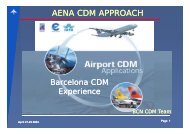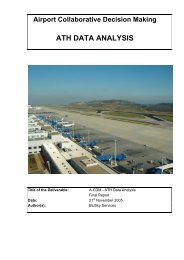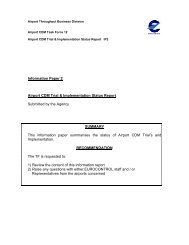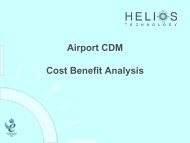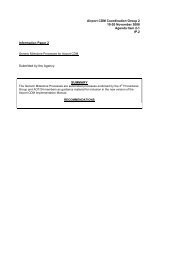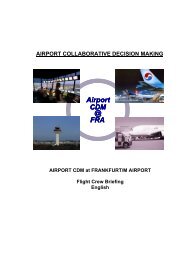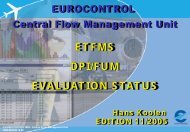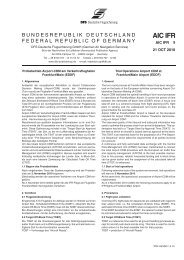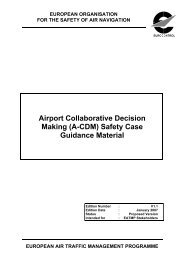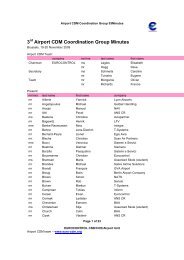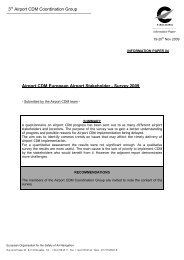Meeting Minutes - Airport Collaborative Decision Making
Meeting Minutes - Airport Collaborative Decision Making
Meeting Minutes - Airport Collaborative Decision Making
You also want an ePaper? Increase the reach of your titles
YUMPU automatically turns print PDFs into web optimized ePapers that Google loves.
<strong>Airport</strong> CDM Coordination Group <strong>Minutes</strong> 02<br />
2 nd <strong>Airport</strong> CDM Coordination Group - <strong>Minutes</strong><br />
Brussels, 19-20 November 2008<br />
Chairman: Lagios Elisabeth EUROCONTROL / AOE<br />
Hogg Dave EUROCONTROL / AOE<br />
Secretary: Tuinstra Eugene EUROCONTROL / AOE<br />
Schmeits Caroline EUROCONTROL / AOE<br />
OK<br />
Present:<br />
Mrs. Banke Rasmussen Nina Integra A/S<br />
OK Mr Batista Joao L ANA Aeroportos de Portugal<br />
OK Mr. Bernard-Peyre Lionel EGIS<br />
OK Mr. Böhme Dietmar DLR<br />
Air France - Direction du Contrôle<br />
OK Mr. Boniface Pierre<br />
des Operations<br />
OK Mr Branagan Neil Irish Aviation Authority<br />
OK Mr. Brandes Michael FLIGHT Explorer<br />
OK Mr Bratlie Svein Avinor<br />
OK Mr Campbell Paul Nats<br />
OK Mr Cass Lorne NWA<br />
OK Mr. Čermák Ladislav ANS Prague<br />
OK Mr Chang Sing Pang Marc Amsterdam <strong>Airport</strong> schiphol<br />
OK Mr. Cheverton Eamonn HPN (BAA)<br />
OK Mr Church Colin BAA<br />
OK Mr. Coenen Albert SN Brussels<br />
OK Mr De Bolle Kris Brussels <strong>Airport</strong> Company<br />
OK Mr De Breucker Wim Flightcare<br />
OK Mr de Nijs Luc NLR<br />
OK Ms De Rademaeker Karin Aviapartner<br />
OK Mr. De Rover Cees Jan KLM Royal Dutch Airlines<br />
OK Mr. De Ruytter Joeri Frequentis GmbH<br />
OK Mrs. Distler Manuela Fraport AG<br />
OK Mr Duret Francois GVA <strong>Airport</strong><br />
OK Mr. Eleftheriou Velissarios<br />
Page 1 of 23<br />
Aviation Solutions Europe Ltd.<br />
EUROCONTROL <strong>Airport</strong> Operations & Environment Division
<strong>Airport</strong> CDM Coordination Group <strong>Minutes</strong> 02<br />
OK Mr. Evans John AirRadio Ltda<br />
OK Mr. Fella Heiko DFS<br />
OK Mr. Geens Luc IACA<br />
OK Mr. Goni Modrego Eduardo EUROCONTROL<br />
OK Mr Groppe Matthias Lufthansa<br />
OK Mrs. Guichard Christine Aeroports de Paris<br />
OK Mr. Hardy Tim BAA<br />
OK Mr. Hearnden Len IATA<br />
OK Mr Herweijer Arie Hitt<br />
OK Mr. Hesselink Henk NLR<br />
OK Mr Hilger Stefan Fraport<br />
OK Mr Hocq Didier Brussels Slot Coordination<br />
OK Mr. Hodge Derek EUROCONTROL<br />
OK Mr. Hogg Dave EUROCONTROL<br />
OK Mr. Howarth Graham XPX Consulting<br />
OK Mrs. Huegel Carol Sensis Corporation<br />
OK Mr Jirku Juraj Helios<br />
OK Mrs King Andrea Helios<br />
OK Mr Koslacz Grzegorz Pansa<br />
OK Mr. Kucera Martin Prague International <strong>Airport</strong><br />
OK Mr. Kurzweil Libor Prague International Air port<br />
OK Mrs. Lagios Elisabeth EUROCONTROL<br />
OK Mr. Lane Roger EUROCONTROL<br />
OK Mr. Leeman Eugene Amsterdam <strong>Airport</strong> Schiphol<br />
OK Mr Libby Mark FAA<br />
OK Mr. Lirola Javier IBERIA L.A.E. DOPS<br />
OK Mr. Lucas Didier DSNA<br />
OK Mr Marfurt Eric Skyguide<br />
OK Mrs Martin-Macho Maria Isabel Iberia<br />
OK Mr. Matthys Marc Belgocontrol<br />
OK Mr Mernock Rick Manchester <strong>Airport</strong><br />
OK Mrs. Meyer Maria Christina EUROCONTROL<br />
OK Mr. Mongenie Olivier EGIS AVIA<br />
OK Mr. Moura Marcos Comitato Utenti<br />
OK Mr Mowery Marshall FAA<br />
OK Mr. Niemeijer Sander KLM Royal Dutch Airlines<br />
Page 2 of 23<br />
EUROCONTROL <strong>Airport</strong> Operations & Environment Division
<strong>Airport</strong> CDM Coordination Group <strong>Minutes</strong> 02<br />
OK Mr Niewinsky Jarak Pansa<br />
OK Mr. Noel Michel private<br />
OK Mr Opdenberg Emmanuel Aviapartner<br />
OK Mr Pauwels Wim Hitt<br />
OK Mrs. Pillan Aline DSNA<br />
OK Mr Ploeckinger Juergen Austrian Airlines<br />
OK Mr. Porfiri Stefano SELEX - Sistemi Integrati<br />
OK Mr Reed Ron SITA <strong>Airport</strong> Solutions Line<br />
OK Mr Reid Timothy NWA<br />
OK Mr Rodrigues Joao NAV<br />
OK Mr. Rodriguez Gonzalo Indra<br />
OK Mr Roos Jan-Olof LFV<br />
OK Mr. Roubicek Jiří Czech Airlines<br />
OK Mr. Roubicek Tomáš Czech Airlines<br />
OK Mrs Schmeits Caroline EUROCONTROL<br />
OK Mr. Sinz Erik DFS Deutsche Flugsicherung GmbH<br />
OK Mr Spencer Stephen Lockheed Martin<br />
OK Mrs Stavrati Ourania A.I.A. Air Traffic Services<br />
OK Mr. Stensjøen Hans Petter AVINOR flysikringsdivisjonen<br />
OK Mr Suorto Timo Finavia<br />
OK Mrs. Tinge Linda DAA<br />
OK Mr. Tuinstra Eugene EUROCONTROL<br />
OK Mr Tykal Miroslav ANS<br />
OK Mr Van Buuren Jos Amsterdam <strong>Airport</strong> Schiphol<br />
OK Mr Van Leeuwen Eric Amsterdam <strong>Airport</strong> Schiphol<br />
OK Mr Veenema Arno Amsterdam <strong>Airport</strong> schiphol<br />
OK Mr. Volf Jiří Czech Airlines<br />
OK Mr. Waltman Henk LVNL<br />
OK Mr Wehle Klaus DFS/TWR FRA<br />
OK Mr Zammit Ludgardo EUROCONTROL<br />
Apologies<br />
EX Mrs. Santacroce Arianna ENAV<br />
EX Mr. Behne Jens-Dietrich T Systems<br />
EX Mrs. Dillen Ann Thomas Cook Airlines Belgium nv<br />
EX Mr. Erdelyi Joe Aviance<br />
EX Mr. Duvekot Cees KLM<br />
Page 3 of 23<br />
EUROCONTROL <strong>Airport</strong> Operations & Environment Division
<strong>Airport</strong> CDM Coordination Group <strong>Minutes</strong> 02<br />
EX Mr Kaler Curt FAA<br />
EX Mr Vandeputte Jan Flightcare<br />
EX Cap. Genova Ricardo Iberia<br />
EX Mr. Saetre Anders AVINOR - Division Regional <strong>Airport</strong>s<br />
EX Mr. Horton Daniel FAA<br />
EX Mrs. Pirotta Gabriella Alitalia<br />
EX Mr Frank Gerald Munich <strong>Airport</strong><br />
EX Mr wetterwik Sven LFV<br />
EX Mr Aillerie Yannick Aeroport deLyon<br />
EX Mr Wobmann Jonas Skyguide<br />
EX Mr. Kanzler Peter Flughafen Munchen GmbH<br />
EX Mr. Torel Patrick Thomas Cook Airlines Belgium nv<br />
EX Mr. Suhner Werner Swiss International Airlines<br />
EX Mr. Brandt Francois Geneva International <strong>Airport</strong><br />
EX Mr. Gammel Andreas UNIQUE<br />
EX Mrs Oluklu Derya ,<br />
EX Mr. Kerski Manfred Taacs<br />
EX Mrs. Drappier Christel Thomas Cook Airlines Belgium nv<br />
EX Mr. Hanbury Joe JFH Assossiates Ltda<br />
Sea Handling S.p.A Aeroporti di<br />
EX Mrs. Turri Paola<br />
Milano (MXP)<br />
EX Mr. Simons Rohnny Thomas Cook Airlines Belgium nv<br />
The contact list will be made open to all for bilateral communication.<br />
DAY 1<br />
1 Introduction to CG<br />
1.1 Opening Remarks & Introduction<br />
The Chair Elisabeth Lagios & Dave Hogg opened the meeting by welcoming all participants to the<br />
second <strong>Airport</strong> CDM Coordination Group.<br />
Page 4 of 23<br />
EUROCONTROL <strong>Airport</strong> Operations & Environment Division
<strong>Airport</strong> CDM Coordination Group <strong>Minutes</strong> 02<br />
1.2 Agenda<br />
The CG / 02 agenda was accepted with no changes.<br />
1.3 <strong>Minutes</strong><br />
CG / 01 minutes were approved with no comments received. All outstanding actions from<br />
previous Coordination Group meeting have been completed.<br />
1.4 Implementation Progress on <strong>Airport</strong>s<br />
Most airports had provided EUROCONTROL with <strong>Airport</strong> CDM implementation status reports for<br />
their airports (See IP 1) which Dave Hogg introduced and invited any airport representatives to<br />
verbally add to their reports if required. The EUROCONTROL <strong>Airport</strong> CDM team additionally<br />
reported on progress at <strong>Airport</strong>s not represented in the meeting.<br />
Amsterdam received a formal go decision by COO’s on the 14 th of November, which is<br />
considered an important step to proceed with implementation after some delay. Earlier a GAP<br />
analysis had already been conducted, as well as extensive training by Eurocontrol. A CBA is<br />
considered essential for bigger organisations, as it provides guideline and clarity to all levels<br />
involved. Implementation is expected to proceed in 2009. A signed MoU is still missing and would<br />
ensure continued commitment by the airport partners.<br />
Athens is currently performing TSAT trials using the EUROCONTROL/DLR Departure Manager<br />
prototype, in order to demonstrate <strong>Airport</strong> CDM feasibility within ATC. Since the Olympics in 2004<br />
<strong>Airport</strong> CDM Information Sharing has been implemented, however the crucial ATC involvement<br />
has not been established. Further trials will contribute to decision making in 2009 on how to<br />
proceed.<br />
Barcelona has paused implementation for some time, however continued development of<br />
procedures for future message data exchange with the CFMU. <strong>Airport</strong> CDM implementation is<br />
expected to pick up momentum early 2009.<br />
Budapest has implemented a new ATM system recently which had priority. However CDM will<br />
gain priority in 2009.<br />
Brussels A MoU has been signed by all partners, which was an important step after some<br />
setbacks. Live trials with CFMU DPI are expected early December 2008.<br />
Berlin Brandenburg will be opened in 2012 as the new Berlin airport. Berlin Tegel will not have<br />
CDM as it will be closed soon. Schonefeld is under consideration.<br />
Dublin has strategy meetings ongoing, after a successful GAP analysis. Full support is available<br />
from the stakeholders and implementation is about to commence. However also in Dublin a new<br />
Page 5 of 23<br />
EUROCONTROL <strong>Airport</strong> Operations & Environment Division
<strong>Airport</strong> CDM Coordination Group <strong>Minutes</strong> 02<br />
ATM system is having priorities over CDM currently. Participation to this CG is considered a<br />
learning process.<br />
Frankfurt used the 2007 DMAN project as a learning session. In May 2008 the choice was made<br />
to implement <strong>Airport</strong> CDM. A MoU was signed and a Gap Analysis conducted. The Milestone<br />
process is considered the most vital process to implement, and preparations are ongoing. Close<br />
coordination takes place with Munich airport, Erik Sinz is the point of contact. DMAN may return<br />
later in the pre-departure sequencing concept element, once requirements are captured and<br />
specified. A lesson learned is to implement <strong>Airport</strong> CDM before DMAN, since DMAN requires<br />
reliable information from the other concept elements in <strong>Airport</strong> CDM to function accurately.<br />
Geneva A MoU is still missing, however the benefits are considered good for ATC and <strong>Airport</strong>.<br />
More cooperation from airlines is needed to have all partners on board. A GAP analysis has been<br />
done in November 2007. Lessons are learned from late delay messages, since dispatchers are<br />
no longer present in Geneva. A gap exists between Skyguide and Airlines and needs to be<br />
closed. In the future TSAT and DPI messages are expected to solve that problem. The project is<br />
managed by two project managers, one IT, one operation related.<br />
Helsinki will start in 2009 with implementation; preparations are still in an early stage. A MoU is<br />
expected in January 2009. Benefits are expected to be large for all partners. De-icing is currently<br />
considered an independent project, since de-icing is applicable minimum six months per year.<br />
Istanbul is in preparation of implementation after GAP analysis and training. More news is<br />
expected early 2009.<br />
London Heathrow BAA is developing a Total <strong>Airport</strong> Management oriented system for the<br />
purpose of CDM process integration. A business approach with services and processes is<br />
developed for Heathrow, with cooperation from Cambridge University and Manchester. The<br />
landside is clearly an important factor, as well as environmental matters. Launch of the system is<br />
expected in April 2009. BAA leads the architectural work, where NATS is sub-contractor.<br />
It was stated by the audience that procedures and concept should go before system<br />
implementation. Heathrow however proceeds with the business oriented approach for procedures<br />
and services that can achieve the CDM objectives.<br />
Later on additional information was provided. Heathrow expects CDM to contribute to adverse<br />
conditions, as recently many incidents occurred on the airport and status information could help<br />
to recover from those incidents. CDM is expected also to contribute to planning purposes for all<br />
partners, as more reliable information contributes to reduce buffering in resource and flight<br />
planning. Further, a Departure module with TSAT generator will be installed to regulate traffic on<br />
the airport. Service Level Agreements with partners are prepared how and when to update the<br />
TOBT.<br />
Lisbon ATC could not be involved in <strong>Airport</strong> CDM so far, due to priorities with the new ATM<br />
system. It is intended to proceed with implementation in 2009. Implementation of A-SMGCS<br />
Page 6 of 23<br />
EUROCONTROL <strong>Airport</strong> Operations & Environment Division
<strong>Airport</strong> CDM Coordination Group <strong>Minutes</strong> 02<br />
systems is related. A lesson learned is that different partners are not aligning their planning on<br />
each other, this is why delay occurred.<br />
Lyon A GAP analysis was conducted in October this year. A presentation will be given to the<br />
Association of French Speaking (regional) <strong>Airport</strong>s in Mulhouse, on the 5 th of December 2008.<br />
The wish to implement is growing among French airports, however further steps are expected in<br />
2009.<br />
Manchester is about to initiate preparations for implementation, as the airport has formally<br />
decided to proceed with <strong>Airport</strong> CDM. As Manchester does not have one base carrier airline,<br />
work is initiated with AOC to gather the partners for project preparations. Eurocontrol will present<br />
the <strong>Airport</strong> CDM concept and potential benefits to the <strong>Airport</strong> partners in Jan 2009.<br />
Munich reported that since June 2007 CDM is still working and providing benefits. The MoU has<br />
been converted into a contract between Munich <strong>Airport</strong> and DFS. Later on ES will present more<br />
on the ongoing developments in Munich airport. The Chair praised the Munich CDM team once<br />
more for the work and commitment in establishing full CDM implementation as part of daily<br />
operations.<br />
Oslo A GAP analysis was conducted late 2006. This year the project manager has been<br />
appointed, and CDM has been communicated to all partners. With this common awareness, the<br />
MoU is being prepared and will be signed within weeks. A good culture is established and all<br />
partners are seeing the benefits. All are preparing for integration of planning systems. Some<br />
delay was caused by investments into a new terminal building. It was concluded that part-time<br />
project management did not work well, one need a full time manager for this project.<br />
EUROCONTROL has recently conducted a one day training course in Oslo to familiarise the local<br />
partners with <strong>Airport</strong> CDM and potential benefits.<br />
Palma de Mallorca has received the GAP analysis in September 2008 as part of the<br />
EUROCONTROL – AENA action plan. Currently this is under consideration. It is expected to<br />
commence with the project in 2009. Madrid and Barcelona will hopefully follow in 2009..<br />
Paris CDG is proceeding well with implementation of <strong>Airport</strong> CDM. Communication amongst<br />
partners is increasing, Information Sharing is considered to be successful via intranet web<br />
services. Procedures are developed and implemented in cooperation with partners; pre-departure<br />
sequencing will be live end 2009, as well as other concept elements. Also a MoU is being<br />
prepared by the main partners ADP, DSNA, Air France, and other partners.<br />
Paris Orly is currently not yet preparing implementation. This is expected to commence in 2009.<br />
Prague presented the state of <strong>Airport</strong> CDM in a presentation.<br />
The airport has effectively one runway operational due to growth and regulations on other<br />
runways. A new runway is planned to be operational within five years.<br />
Page 7 of 23<br />
EUROCONTROL <strong>Airport</strong> Operations & Environment Division
<strong>Airport</strong> CDM Coordination Group <strong>Minutes</strong> 02<br />
<strong>Airport</strong> Capacity Enhancement analysis was performed end 2006. A CBA was conducted early<br />
2008, and in March 2008 implementation was agreed amongst partners. Technical work is<br />
conducted in phase 1 of the project; interfacing of existing systems is important for information<br />
sharing. A PDA function is selected for mobile awareness and inputs for ramp agents, in this<br />
phase. This will increase TOBT updates and Information Sharing.<br />
Phase 2 will contain the Pre-departure Sequencing; phase 3 will be the connection with CFMU<br />
regarding exchange of DPI messages.<br />
It is stated once more that the project manager must be a full time function. <strong>Airport</strong> CDM is<br />
considered to be the key concept in SESAR, and harmonisation of the concept among European<br />
stakeholders is essential. It is agreed that CDM can also be useful for less constraint airports, as<br />
the aircraft and foreign carrier can benefit of early information and predictions.<br />
Milan is facing economical problems and has lost its hub function due to Alitalia relocating to<br />
Rome. No further CDM steps expected in the short term. A mandate from the governments could<br />
help the implementation process back on track.<br />
Rome Fiumincino has done a GAP analysis which was accepted in 2007. Currently; airline<br />
problems are priority which prevents further progress at the moment. However Airlines and CAA<br />
are pushing for implementation which is expected to commence in the near future.<br />
Stockholm Arlanda has rejoined <strong>Airport</strong> CDM after DMAN trials end 2007. Currently the project<br />
is under preparation for implementation and expects to restart in 2009.<br />
Vienna has signed a letter of intent between the main partners after a period of slow down since<br />
the end of 2007. The convincing of partners took a long time and the first phase of<br />
implementation has been completed awaiting board approval early 2009 for the commencement<br />
of full implementation.<br />
Warsaw has good cooperation between partners, a MoU is agreed and a project manager to be<br />
appointed soon. Already the airport and ANSP are moving fast forward with implementation, other<br />
partners following. More progress to report in 2009.<br />
An extensive overview of all airport progress report can be found on the CDM website www.eurocdm.org.<br />
1.5 Project Developments<br />
Website<br />
Caroline Schmeits provided an update by showing the new website on the screen. Outline of the<br />
new functionality, where to easily find all documentation, what links, and how to make contact<br />
with the Eurocontrol team was presented. It is expected to be ‘live’ before Christmas 2008.<br />
Page 8 of 23<br />
EUROCONTROL <strong>Airport</strong> Operations & Environment Division
<strong>Airport</strong> CDM Coordination Group <strong>Minutes</strong> 02<br />
R It was recommended to add some pages that explain “what CDM can do for you”, to<br />
attract people to read further on the website, and directly see the benefits for themselves. It is<br />
important that the first click on the website brings the reader on a page that invites him to read<br />
more.<br />
Events will be clearly visible on the website, a rough year-agenda will be added for high level<br />
view of the CDM year. Dated events will be on the news room, and also have a direct link to<br />
relevant documents.<br />
Q Why not a forum online?<br />
A This is difficult to maintain for a small Eurocontrol team. Also some risks are involved<br />
which we do not wish to consider at this stage. Eurocontrol will however always consider more<br />
interactivity and is open for improvement of services.<br />
Q Are the airport progress reports online?<br />
A Yes, all active airports will have their latest reports online.<br />
The website address is: www.euro-cdm.org.<br />
Implementation Manual<br />
Eugene Tuinstra (ET) provided a verbal overview on the progress of the new Implementation<br />
Manual. It will contain recent developments such as the Milestone Processes and related Alert<br />
Messages. Other additional sections involve a high level organisation structure. Also all<br />
implementation chapters have been thoroughly updated and aligned with best practices or other<br />
project developments (e.g. SESAR). Finally, the Manual will be having a complete new look, in<br />
order to reflect change and new spirits.<br />
The new version is expected to be ready for download before Christmas 2008. The paper version<br />
of the complete map will be ready early 2009, as printing requires some extra measures. It will be<br />
decided in the next month how many copies will be delivered to each airport project management.<br />
All airports were thanked for their contribution to the enhancements of the manual.<br />
Train the Trainer Course<br />
This course is a new package to be developed over 2009, with the purpose to instruct local<br />
airport trainers. Lack of resources within Eurocontrol prevents the team to assist implementation<br />
at all airports in Europe. Hence support for instructors at local or national level needs to be<br />
provided through a train the trainer package, for which partners need to provide instructor<br />
capacity.<br />
It is important to have short time periods between instructors training and the training by these<br />
instructors to operational staff at an airport where CDM is implemented.<br />
Page 9 of 23<br />
EUROCONTROL <strong>Airport</strong> Operations & Environment Division
<strong>Airport</strong> CDM Coordination Group <strong>Minutes</strong> 02<br />
R It is considered the best training when instructors from multiple partners of one airport are<br />
trained jointly, in order to dispose the culture of one organisation to others, and learn from each<br />
other.<br />
R Munich trained them selves during implementation, as they were the pioneer airport to<br />
implement <strong>Airport</strong> CDM.<br />
Marketing & Communication<br />
Currently a new Marketing Guide is under development by the contracting party Helios. This<br />
guide is the magazine version of several relevant <strong>Airport</strong> CDM topics, easy to ready for both<br />
management and operational staff of airport stakeholders. Aim is to launch the magazine early<br />
2009, which reflects also a new phase of <strong>Airport</strong> CDM now that more than 25 airports are<br />
involved.<br />
The magazine shows benefits, concept elements, operational impact for staff, and many other<br />
interesting subjects to motivate people working on airports. During this meeting Helios will contact<br />
people to provide their view on the current status of the magazine, in order to take their feedback<br />
on board.<br />
R A proposal was made to add a checklist for CDM in the centre of the magazine.<br />
R Another remark was made that the document might not be read by many people, as it is<br />
too much paper, not readable. A leaflet might be better.<br />
Comments have been taken on board, however the Eurocontrol team thinks this magazine can<br />
be readable as it does not contain a long story, but many independent topics interesting for a<br />
wide range of readers.<br />
2 Procedures Group & DPI message development<br />
2.1 Procedures Group <strong>Meeting</strong> report<br />
Elisabeth Lagios (EL) explained the importance of the new Generic Milestone processes (IP2)<br />
document for implementing the Information Sharing and Milestone approach concept elements.<br />
Changes have been added to reflect the status of the concept, hard requirement statements as<br />
“should” and “shall” have been replaced by “recommended” and “highly recommended”.<br />
However, once a mandate from the European Commission may come these statements may be<br />
reversed.<br />
The Alert Messages document (IP3) has been slightly revised in the introduction table, which<br />
was not correctly updated. A remark was received to change the coding of messages, or to align<br />
with Flight Objects in SESAR. Both documents are reflected in the new Implementation Manual,<br />
to be released soon.<br />
The Start-up procedures document (WP1) is still under development in the Procedures Group.<br />
The same accounts for the Generic AIP text document (WP2). Both documents will be discussed<br />
Page 10 of 23<br />
EUROCONTROL <strong>Airport</strong> Operations & Environment Division
<strong>Airport</strong> CDM Coordination Group <strong>Minutes</strong> 02<br />
in the next Procedures Group meeting, on the 4th & 5 th of February 2009, which is accessible to a<br />
limited group of airports. Comments on these documents are welcome from all stakeholders, to<br />
be received before the 5 th of December 2008.<br />
R SN Brussels Airlines reflected that EOBT should be the main parameter to be used, not<br />
TOBT.<br />
A EOBT contains an uncertainty of a ±15 minutes window, which is the main justification for<br />
the <strong>Airport</strong> CDM concept. TOBT is considered the key parameter in <strong>Airport</strong> CDM, which aims to<br />
provide more reliability in planning, implemented by many airports, and supported by all partners.<br />
This way of thinking of SN Brussels Airlines does not reflect the general feeling. Brussels as CDM<br />
airport should evaluate how to proceed.<br />
R Feedback from APN and APDSG is aimed at phraseology which must be aligned with<br />
ICAO. Acronyms in datalink are not allowed these days, and it should be debated how to<br />
proceed.<br />
2.2 CFMU DPI message exchange<br />
This section is combined with 2.3, as there was only one integrated presentation on this subject.<br />
2.3 CFMU minimum Requirements for DPI implementation<br />
Marcel Richard (MR) presented the minimum requirements for CFMU to connect an airport with<br />
DPI messages. The message was that all concept elements of <strong>Airport</strong> CDM must have been<br />
implemented successfully, in order to guarantee reliable information and hence reliable<br />
predictions on TTOT from the airport to CFMU. Further: slot compliance, presence of letter of<br />
intent or MoU between airport partners is essential before transmission between airport and<br />
CFMU can occur.<br />
Once an airport fulfils the requirements, an evaluation trial is planned in order to verify the<br />
information exchange between airport and CFMU. However, the operational requirements are the<br />
basis for a decision if and when an airport will be connected, not technical.<br />
R It was suggested to have a long Stakeholder comment phase for this document, as it<br />
contains some controversial statements.<br />
A The document has been created initially for internal purposes, and budget planning and<br />
resources between Eurocontrol units. The relevance of this document is for future situations when<br />
we need to make choices between airports that are ready for DPI exchange with CFMU. The<br />
document is open for discussion and comments. The comment phase will be until 20 January<br />
2009.<br />
R The document is not derived in a democratic way, as stakeholders were not involved.<br />
Amsterdam is opposing chapter 4, and is supported by others, including Munich. The<br />
performance figures required are too high, and should be reassessed.<br />
Page 11 of 23<br />
EUROCONTROL <strong>Airport</strong> Operations & Environment Division
<strong>Airport</strong> CDM Coordination Group <strong>Minutes</strong> 02<br />
A Despite this, figures are also guidelines and can be taken flexible. It is understood that<br />
this communication does not reflect that flexible view. e.g. de-icing conditions may influence slot<br />
compliance, and in such case not be taken into account for measurements.<br />
Q Is the main carrier on an airport not in advantage with <strong>Airport</strong> CDM? In Munich this is the<br />
case today. Because one airline (Lufthansa) receives adjusted slots, other airlines in Europe lose<br />
slots due to exchange of slots by CFMU. This way is considered not fair to other airlines.<br />
A This is the situation today. When more airports implement <strong>Airport</strong> CDM, this effect will be<br />
reduced, and all airlines start benefiting from the concept of slot swapping by CFMU.<br />
Q Who decided on the figure of 95%? It is too rigid.<br />
A The figure of 95% does not relate compliance, it is the number of traffic on one airport<br />
that is expected to deliver TOBT to the CDM platform, which then triggers TTOT message to<br />
CFMU. This explanation is however not understood by all participants. All numbers need<br />
endorsement in OCG, hence stakeholders can have their say.<br />
Q Will these figures be evaluated when more airports are involved in exchange with CFMU?<br />
A Yes, evaluation takes place constantly, and the document should be adjusted<br />
accordingly.<br />
R Not just the figures require evaluation; all elements of the document should be discussed.<br />
A 20 January is the deadline for comments on the Minimum requirements document.<br />
EUROCONTROL / IATA Flight Efficiency Plan<br />
3.1 How <strong>Airport</strong> CDM can help Airlines to survive<br />
Len Hearden (LH) presented the IATA view on <strong>Airport</strong> CDM. A first note however was given to a<br />
statement by SN Brussels Airlines, who rejected the use of TOBT in <strong>Airport</strong> CDM. The statement<br />
was noted for the record. Dave Hogg (Chairman) informed all participants that this statement was<br />
to negative without any substance and should be ignored considering SN Brussels were not<br />
present to substantiate on the reasons for such a comment.<br />
LH explained about rising fuel prices (despite the current downturn), dropping seat figures and<br />
more financial impact on the Airlines today, which is resulting in a plea for more enhanced airport<br />
operations, such as <strong>Airport</strong> CDM.<br />
On the arrival side a new principle should be endorsed: First Scheduled First Served. Arrival<br />
applications should then be available for slot swapping, where efficiency requires and possibilities<br />
enable to do so.<br />
Q What about the very confusing message SN Brussels Airlines just gave to IATA, which<br />
was loudly presented?<br />
A IATA is in full support of <strong>Airport</strong> CDM, and the voice was only from one stakeholder.<br />
Page 12 of 23<br />
EUROCONTROL <strong>Airport</strong> Operations & Environment Division
<strong>Airport</strong> CDM Coordination Group <strong>Minutes</strong> 02<br />
A SN Brussels Airlines signed the MoU for Brussels airport, so they should be supporting<br />
CDM in full. Feedback however regarding the TOBT statement will be given to the airline as soon<br />
as possible, as the confusion is not contributing to the participants and future interested airports.<br />
Q How does IATA push member airlines to implement and comply with <strong>Airport</strong> CDM<br />
procedures?<br />
A IATA has difficulty in pushing their members via top management. It was agreed to do<br />
more where possible.<br />
Q How about the IATA – ACI agreement?<br />
A ACI involve their members already in close cooperation with EUROCONTROL, as they<br />
already have an agreement in place. A joint initiative from organisations to their members would<br />
contribute significantly.<br />
R Standardisation from a pilot perspective is of key importance, hence pilots will urge their<br />
airlines bottom-up to proceed with CDM, and so should IATA do from top-down.<br />
3.2 Pilot experiences on the benefits of <strong>Airport</strong> CDM<br />
Matthias Gröppe (MG) presented the pilot perspective on <strong>Airport</strong> CDM. He pointed out the mixed<br />
signals they are receiving at different airports, such as Zurich where still POBT is used rather<br />
than TOBT.<br />
The role of the pilot in the turn-round process becomes more important due to the reduction of<br />
ramp agents or dispatchers. Their awareness level may differ between airlines, but generally<br />
spoken they are supposed to be aware of many small and big processes in and around the<br />
aircraft. Lufthansa has one process in place to deliver TOBT and updates to the responsible<br />
persons at the platform, which works already in Munich.<br />
3.3 Open Session<br />
Q Are acronyms already filed to ICAO?<br />
A No, this has not been done yet. Short term action is needed in order to brief ICAO on<br />
procedure developments and standardisation of acronyms.<br />
R A generic process for TOBT updates should be applied throughout all airports.<br />
A True, however the role of the pilot should allow for exception handling, since he is the<br />
only individual in the loop close to TSAT, in order to update planning.<br />
R For this already a new TOBT datalink procedure is discussed and agreed in the<br />
Procedures Group meeting.<br />
Page 13 of 23<br />
EUROCONTROL <strong>Airport</strong> Operations & Environment Division
DAY 2<br />
<strong>Airport</strong> CDM Coordination Group <strong>Minutes</strong> 02<br />
FAA Future cooperation<br />
This session has actually taken place on the first day due to change of schedule. EL introduced<br />
the guests from FAA, with whom she visited Munich the day before to show how <strong>Airport</strong> CDM is<br />
working in Europe.<br />
4.1 FAA update on CDM & ground delay program in the USA<br />
Mark Libby (ML) and Marshall Mowery (MM) together with representatives of Delta/North West<br />
Airlines gave a presentation of the CDM developments in the USA.<br />
ML explained the concept of CDM in USA, which is mostly applied for en-route planning, rather<br />
than the airport planning. Weather is the main driver for this en-route planning, but also their<br />
ground-delay program is primarily needed to resolve bad weather situations, demanding change<br />
of plans.<br />
A daily teleconference with all main partners (airlines, FAA, Port authorities) from all over the<br />
USA is executed at the beginning of the morning, in order to identify problem areas or airports in<br />
the National Air Space (NAS), and how to find appropriate mitigations. These types of massteleconferences<br />
are repeated throughout the day, in order to update and align partners. Canada<br />
is involved as well, and soon Mexico will join this way of working.<br />
A culture of No-Blame has grown over the years due to this communication, which is providing an<br />
excellent basis for more collaboration on the airport surface. Security of data for competitive<br />
reasons has been abandoned since all partners came to see the bigger benefits of cooperation<br />
and sharing that data. Now a need for more surface data sharing is needed, a next step in CDM.<br />
MM showed the surface problems during a common day on Atlanta airport. Inbound flows are<br />
hold before entering the terminal area (aprons), due to occupied stands and gates. Outbound<br />
flows queue near the runway holding point, causing delay and emissions.<br />
The essence of the concept is that the aprons are managed by Airlines, whereas the runways<br />
and taxiways are controlled by the FAA (ATC). Flow numbers are modelled by the FAA to predict<br />
outbound traffic, whereas airlines today do not share information on their actual movements and<br />
turn-round processes. More information sharing could therefore enhance efficient use of the<br />
airport infrastructure as a whole. For that reason, and interest into European <strong>Airport</strong> CDM has<br />
grown.<br />
Q Are all airlines included in the daily teleconferences?<br />
A All can participate and listen in, however this is not compulsory.<br />
Page 14 of 23<br />
EUROCONTROL <strong>Airport</strong> Operations & Environment Division
<strong>Airport</strong> CDM Coordination Group <strong>Minutes</strong> 02<br />
Post <strong>Airport</strong> CDM Implementation Performance & Measurement<br />
EL introduced this session by highlighting her appreciation for the larger airlines and their<br />
involvement in defining new procedures and participating in data analysis programs in<br />
Eurocontrol. Especially Munich has been contributing from the beginning and still is the biggest<br />
example for <strong>Airport</strong> CDM to other airports.<br />
5.1 Post Munich <strong>Airport</strong> CDM Implementation including KPIs<br />
Erik Sinz (ES) gave a presentation about the current state in Munich, and developments that are<br />
ongoing to prepare for the future.<br />
Q What CDM information is provided to foreign airlines, since this is not clear to all carriers<br />
abroad?<br />
A The ground handler should inform your airline how to connect to Munich information<br />
sharing system. Options are available; just decide on how to use them.<br />
Q What options exist in Munich to swap flights in the pre-departure sequence?<br />
A The Handling agent can choose to swap flights based on their progress. Star Alliance has<br />
the possibility with many flights to swap flights in the sequence, based on their priorities. However<br />
once a flight is swapped or shifted in time, a stabilisation function is needed to avoid too much<br />
instability for a flight.<br />
Q How about EOBT and TTOT compliance at Munich airport?<br />
A The biggest problem is <strong>Airport</strong> slot SOBT – with flight plan slot EOBT. This check is<br />
crucial to update one of them. General aviation is not a big problem today; they comply via one<br />
operations centre with TOBT, which is sufficient. In the worst case the tower can input a TOBT<br />
via R-T if necessary, which is exceptional.<br />
Q Why not just apply EOBT?<br />
A The EOBT remains valid according to ICAO flight plan regulation. TOBT is more crucial<br />
for FMG and DFS controllers, since it reflects the real state of the aircraft, not just the flight plan<br />
Q Does Munich have a MoU in place? What are the costs for airlines today?<br />
A FMG and DFS have a contract in place. All CDM costs are shared by DFS and FMG,<br />
together they developed SEPL. Airlines and Ground Handlers only have their own costs to bear.<br />
Q What are the development costs for CDM at Munich?<br />
A 1 Million EUR in total. FMG can provide you with more detail on costs.<br />
Q What are the biggest benefits for Munich?<br />
A Reduced queuing of 1 minute average per flight; reduced taxi times per flight, minimised<br />
delay at the gate; CFMU providing suiting CTOT slots to flights based on TTOT prediction.<br />
Page 15 of 23<br />
EUROCONTROL <strong>Airport</strong> Operations & Environment Division
<strong>Airport</strong> CDM Coordination Group <strong>Minutes</strong> 02<br />
R Europe should discuss centralised information sharing, as too many airports develop their<br />
own type of database and information sharing. One big database would be more convenient for<br />
airlines which fly to many different airports with as many different systems to log on to.<br />
A All airlines have access to the CFMU database, which reflect much information. All<br />
AOC’s have such CFMU terminal, however TOBT not presented in this database.<br />
R CFMU takes constructive proposals to extend their database with CDM data display.<br />
A Airlines should discuss TOBT publication within IATA. That would provide a huge benefit<br />
for airlines to follow their outstation flight progress more easily.<br />
R However some airlines do not want publication of TOBT in the DPI message, due to<br />
competition.<br />
5.2 EUROPEAN <strong>Airport</strong> CDM Data Analysis<br />
Andrew Hill presented a proposal for analysis of <strong>Airport</strong> CDM data of several airports. The<br />
request was to receive data sets from interested airports. With the analysis of data airports could<br />
get free reporting on their performance of <strong>Airport</strong> CDM. Furthermore, European trends could be<br />
derived from larger datasets. However it was stressed that all airport data would be treated<br />
confidentially, as was done in other data analysis projects.<br />
R Heathrow expressed interest; their data could be provided via access to their platform.<br />
Q Is there a link to the ATMA data analysis project, also performed by Eurocontrol?<br />
A The scope of ATMA is unclear, however contact is made and coordination with other<br />
projects will take place. Aim of this project is to feedback performance to airports.<br />
Q How about the metrics EOBT – SOBT and TOBT – ARDT?<br />
A All Metrics will be discussed.<br />
A general conclusion was that Eurocontrol should ensure coordination with other projects, to<br />
avoid double datasets being sent to different units in Eurocontrol. This was taken on board.<br />
5.3 Enhancing TOBT accuracy in EUROPE<br />
A presentation from ET showed that todays TOBT values are often inaccurate or missing, leading<br />
to poor TSAT and TTOT calculations. Unawareness, poor CDM implementation, inexperienced<br />
staff and inaccurate performance analysis were looked at as possible causes. Better staff training<br />
on CDM, airline evaluation and increased pilot involvement could improve the accuracy of the<br />
TOBT input locally. The exchange of better practices and a Community specification could help.<br />
SN Brussels Airlines said that TOBT is becoming as inaccurate as the EOBT. Updating this last<br />
one is already difficult enough, no need for updating another one with the same value. In Munich<br />
TOBT is mandatory, but a first service of automatic TOBT is provided. (ES)<br />
It was remarked that awareness, training and communication are different for every stakeholder<br />
and that they need to grow together on operational level to improve overall CDM behaviour.<br />
Page 16 of 23<br />
EUROCONTROL <strong>Airport</strong> Operations & Environment Division
<strong>Airport</strong> CDM Coordination Group <strong>Minutes</strong> 02<br />
With a plea from MG to involve the pilots, it was proposed to have a presentation in a future<br />
Coordination Group meeting on ‘the Ground Handlers Perspective’.<br />
Involving CEO’s from AO as from the start, as they are the signers of the MoU, is preferable.<br />
Eurocontrol has a responsibility to talk to IATA, Pilot -,Ground Handler- and Airline Associations<br />
to raise more and more awareness.<br />
5.4 <strong>Airport</strong> CDM Network gains (Benefit Assessment)<br />
Maria-Christina Meyer (MCM) and Eduardo Goni (EG) gave a presentation about the potential<br />
network gains in Europe after <strong>Airport</strong> CDM has been implemented in 42 airports. This research is<br />
done based on actual CDM information from Munich airport, and the results are expanded to<br />
other airports. Benefits are expected in capacity growth per sector, and even a more efficient use<br />
of airspace and less regulation due to less saturation of sectors.<br />
The EUROCONTROL DMEAN program manager adds on that for more flight efficiency a network<br />
approach must be taken to tackle Airspace design, Air routes and Flow management, with<br />
integration of airports in the network. All the benefits that are expected will reduce the amount of<br />
needed regulations, which is the result this program aims for.<br />
Q If the number of saturated sectors decreases, does this imply that also the regulation<br />
goes down?<br />
A This cannot be concluded from this research, and must be verified in future work. The<br />
assumption is anyhow too straight forward, as there is no direct relation between saturation and<br />
regulation levels.<br />
Q How is DMEAN communication organised to ANSPs?<br />
A There is training planned for ANSP and FMP’s, in the near future.<br />
Q Is this research not too early for conclusions? One feeding airport is not much to base<br />
these results on? There are big problems with flight level compliance between sectors, too many<br />
controllers use another flight level to solve conflicts or rerouting, not adhering to the flight plan.<br />
A Controllers deviating from the flight plan may cause inefficient use of airspace, and<br />
trigger regulations by CFMU. Due to lack of training of controllers flight predictions made by<br />
CFMU may not be effective. Controllers should be more aware of their actions with change of<br />
flight levels. Training is essential.<br />
R City pair investigation may be very useful for more reliable results. These results are<br />
preliminary and hence very uncertain. More airports need to implement and operate <strong>Airport</strong> CDM<br />
before more results form a basis to conclude on. However the type of research is considered a<br />
good start.<br />
R Munich investigated a reduction of ATFM delay of 2.4 minute, which must be taken into<br />
account. Once the network benefits from <strong>Airport</strong> CDM, the turn-round process again may benefit<br />
Page 17 of 23<br />
EUROCONTROL <strong>Airport</strong> Operations & Environment Division
<strong>Airport</strong> CDM Coordination Group <strong>Minutes</strong> 02<br />
from the network predictability. CTOT’s from <strong>Airport</strong> CDM airports may become completely<br />
unnecessary in the future.<br />
DMAN / A-SMGCS and <strong>Airport</strong> CDM integration<br />
6.1 DMAN / ASMGCS and <strong>Airport</strong> CDM integration Concept<br />
Klaus Haschke and Eugene Tuinstra gave some feedback on the 2 DMAN Workshops from 2008.<br />
The reason for having an integrated DMAN concept (in <strong>Airport</strong> CDM and A-SMGCS) is that future<br />
advanced concepts require a robust basis on Surface Management. The defined Operational<br />
Concept of DMAN was explained to the Coordination group members and benefits such as<br />
increased operational efficiency and improved environment were summed.<br />
Q Can Pre-departure Sequence be implemented without having the DMAN and A-SMGCS<br />
tools, because this can scare airports, thinking these tools are needed?<br />
A No DMAN sequence planner will function efficiently without accurate data and<br />
procedures in place. DMAN and A-SMGCS real time data will on their turn feed the CDM TSAT<br />
calculation.<br />
ET clarified the difference between the DMAN system (tool) and departure management, together<br />
being the concept as it was important to point out the difference.<br />
Q What is the connection with stand and gate management and how to solve queuing at the<br />
terminal area when queuing at the RWY is solved by the sequence tool?<br />
A This should be solved by having <strong>Airport</strong> CDM process in place together with airport slot<br />
coordination. TOBT is essential and an accurate input for DMAN and still a flexible tool for<br />
controllers and Stand and Gate Management.<br />
Several offers to review the document “Generic Operational Concept for DMAN integration in<br />
<strong>Airport</strong> CDM and A-SMGCS” were taken. The document will be released for review end<br />
December 2008.<br />
6.2 Brussels CDM / DMAN Trial Report<br />
Brussels <strong>Airport</strong> CDM and DMAN evaluation report, hands on experience is also applied on<br />
Athens airport. The report will be published online soon.<br />
Future Developments<br />
7.1 EUROCAE WG/69 & ETSI<br />
EL explained that the work in EUROCAE WG69 is completed and a list of documents has been<br />
approved. Based on this work the European Telecommunications Standardisation Institute (ETSI)<br />
is preparing a Community Specification (CS), which should mandate <strong>Airport</strong> CDM in Europe<br />
through the interoperability regulation of the EC Single European Sky. This mandate is essential<br />
Page 18 of 23<br />
EUROCONTROL <strong>Airport</strong> Operations & Environment Division
<strong>Airport</strong> CDM Coordination Group <strong>Minutes</strong> 02<br />
to push more airports to implement and operate <strong>Airport</strong> CDM. A draft CS can be expected in<br />
2009.<br />
Q Is this CS document public?<br />
A For those who are participants of the WG69, it is. Registration can be done via the UK<br />
CAA.<br />
7.2 EUROCONTROL re-organisation (CND) and fit with SESAR<br />
<strong>Collaborative</strong> Network Design is the new organisation structure for Eurocontrol, in order to line up<br />
for the SESAR program. The structure aims to integrate transparency and Partnership, in order to<br />
reflect the new way of working within the SESAR program.<br />
CND will contain new execution processes and budgets; more can be read on the SESAR and<br />
CND websites.<br />
7.3 Advanced <strong>Airport</strong> CDM Concept<br />
An expansion of the <strong>Airport</strong> CDM concept is being produced as part of future IP2 activity,<br />
however is still to immature for public delivery. It aims to integrate the landside more, which is<br />
missing in the current CDM concept. Main objective is to use more information from the landside<br />
in order to base airside predictions on, in order to improve operational efficiency.<br />
7.4 Other Business & Date for next meeting<br />
<strong>Airport</strong>s that wish to be part of the Procedures group meeting can send a mail to the <strong>Airport</strong> CDM<br />
team. The Procedures Group meeting will be 4-5 February 2009 in Brussels. Agenda to be<br />
finalised and distributed soon.<br />
The <strong>Airport</strong> CDM team will consider how to provide opportunity for industry to expose to the<br />
stakeholders in future events.<br />
Date Next <strong>Meeting</strong> and other Business<br />
The 19th and 20 th November 2009 was agreed for the third <strong>Airport</strong> CDM Coordination Group The<br />
chair closed the meeting at 15.30 hrs.<br />
Actions<br />
ID Description Responsible Due date<br />
CG01 Comment WP1, WP2 All 05/12/08<br />
CG02 Comment CFMU minimum All 20/01/08<br />
requirements for DPI<br />
implementation.<br />
Page 19 of 23<br />
EUROCONTROL <strong>Airport</strong> Operations & Environment Division
<strong>Airport</strong> CDM Coordination Group <strong>Minutes</strong> 02<br />
CG03 Comment on “Generic Operational<br />
Concept for DMAN integration in<br />
<strong>Airport</strong> CDM and A-SMGCS”<br />
Page 20 of 23<br />
HITT, DLR, NLR 20/01/08<br />
EUROCONTROL <strong>Airport</strong> Operations & Environment Division
AGENDA - <strong>Airport</strong> CDM Coordination Group<br />
<strong>Airport</strong> CDM Coordination Group <strong>Minutes</strong> 02<br />
AGENDA FOR THE SECOND MEETING<br />
Pollux meeting room, Agency HQ<br />
Starting at 10:00 on 19th November 2008<br />
Finishing at 15:15 on 20th November 2008<br />
Chair: Elisabeth Lagios, EUROCONTROL <strong>Airport</strong> CDM Project Manager<br />
Co-Chair: Dave Hogg, EUROCONTROL <strong>Airport</strong> CDM Expert<br />
Secretary: Eugene Tuinstra, EUROCONTROL <strong>Airport</strong> CDM expert<br />
Contact: Caroline Schmeits, EUROCONTROL <strong>Airport</strong> CDM expert<br />
Day 1<br />
Session 1, Introduction to CG<br />
Chair: Elisabeth Lagios / Dave Hogg<br />
10:00 1.1 Opening remarks V<br />
10:10 1.2 Adoption of Agenda V<br />
10:15 1.3 Approval of minutes and actions Coordination Group<br />
1<br />
10:20 1.4 Overview of <strong>Airport</strong> CDM Implementation in Europe<br />
(including presentation from Prague airport - 10<br />
minutes)<br />
11:40 1.5 Project Developments<br />
12:30 Lunch<br />
<strong>Airport</strong> CDM Website Transition<br />
<strong>Airport</strong> CDM Implementation Manual Update<br />
Train the Trainer<br />
<strong>Airport</strong> CDM Marketing & Communication<br />
Session 2, <strong>Airport</strong> CDM Procedures Group & DPI Message<br />
Environment Development<br />
Chair: Elisabeth Lagios / Dave Hogg<br />
Page 21 of 23<br />
EUROCONTROL <strong>Airport</strong> Operations & Environment Division<br />
IP1<br />
V<br />
V<br />
V<br />
V<br />
P<br />
EL<br />
DH<br />
ET<br />
DH<br />
CS<br />
ET<br />
EL<br />
Helios
<strong>Airport</strong> CDM Coordination Group <strong>Minutes</strong> 02<br />
13:30 2.1 <strong>Airport</strong> CDM Procedures Group<br />
<strong>Airport</strong> CDM Generic Milestone Processes IP2 V EL<br />
13:40 <strong>Airport</strong> CDM Generic Alert Messages IP3 V<br />
EL<br />
13:50 <strong>Airport</strong> CDM Start up procedures with Datalink WP1 V EL<br />
14:00 <strong>Airport</strong> CDM Harmonised text for AIP WP2 V EL<br />
14:20 2.2 CFMU / <strong>Airport</strong> DPI Message exchange including<br />
de-icing situations<br />
14:50 2.3 CFMU Minimum Requirements for DPI<br />
Implementation<br />
15:10 Coffee break<br />
Session<br />
<strong>Airport</strong><br />
Programme<br />
Update<br />
3, EUROCONTROL / IATA Flight Efficiency Plan<br />
Chair: Elisabeth Lagios / Dave Hogg<br />
15:30 3.1 How <strong>Airport</strong> CDM can help Airlines survive in these<br />
critical times<br />
16:00 3.2 Pilots experiences on the benefits of <strong>Airport</strong> CDM<br />
and Perspective on how to enhance TOBT accuracy<br />
16:30 3.3 Open Session<br />
17:00 Day 1 Close<br />
09:30<br />
10:00 5.1<br />
Session 4,<br />
Strategy<br />
Day 2<br />
FAA & EUROCONTROL Future Coordination<br />
Chair: Elisabeth Lagios / Dave Hogg<br />
4.1 FAA Update on <strong>Airport</strong> CDM in the US & the ground<br />
delay programme<br />
Post <strong>Airport</strong> CDM Implementation Performance &<br />
Session 5,<br />
Measurement<br />
Chair: Elisabeth Lagios / Dave Hogg<br />
Post Munich <strong>Airport</strong> CDM Implementation including<br />
KPIs<br />
Page 22 of 23<br />
EUROCONTROL <strong>Airport</strong> Operations & Environment Division<br />
P MR<br />
IP4 P MR/EL<br />
P<br />
LH<br />
P MG<br />
P ML/MM<br />
P<br />
EZ
10:30 5.2<br />
10:50 5.3<br />
11:10 5.4<br />
11:30 Coffee break<br />
<strong>Airport</strong> CDM Coordination Group <strong>Minutes</strong> 02<br />
EUROPEAN <strong>Airport</strong> CDM Data Analysis WP3 P<br />
Enhancing TOBT accuracy in EUROPE V<br />
<strong>Airport</strong> CDM Network gains (Benefit Assessment) P MCM<br />
Session 6, DMAN / ASMGCS and <strong>Airport</strong> CDM integration<br />
Chair: Elisabeth Lagios / Dave Hogg<br />
12:00 6.1 DMAN / ASMGCS and <strong>Airport</strong> CDM integration<br />
Concept<br />
P<br />
12:30 6.2 Brussels CDM / DMAN Trial Report V<br />
13:00 Lunch<br />
Session 7, Future Developments<br />
Chair: Elisabeth Lagios / Dave Hogg<br />
14:00 7.1 EUROCAE WG/69 & ETSI V<br />
EL<br />
14:10 7.2 EUROCONTROL re-organisation (CND) and fit with<br />
SESAR<br />
P<br />
PJ<br />
14:30 7.3 Advanced <strong>Airport</strong> CDM Concept P<br />
MB<br />
15:00 7.4 Other Business & Date for next meeting V<br />
15:15 FINISH<br />
Page 23 of 23<br />
EUROCONTROL <strong>Airport</strong> Operations & Environment Division<br />
AH<br />
ET<br />
KH/ET<br />
EL



